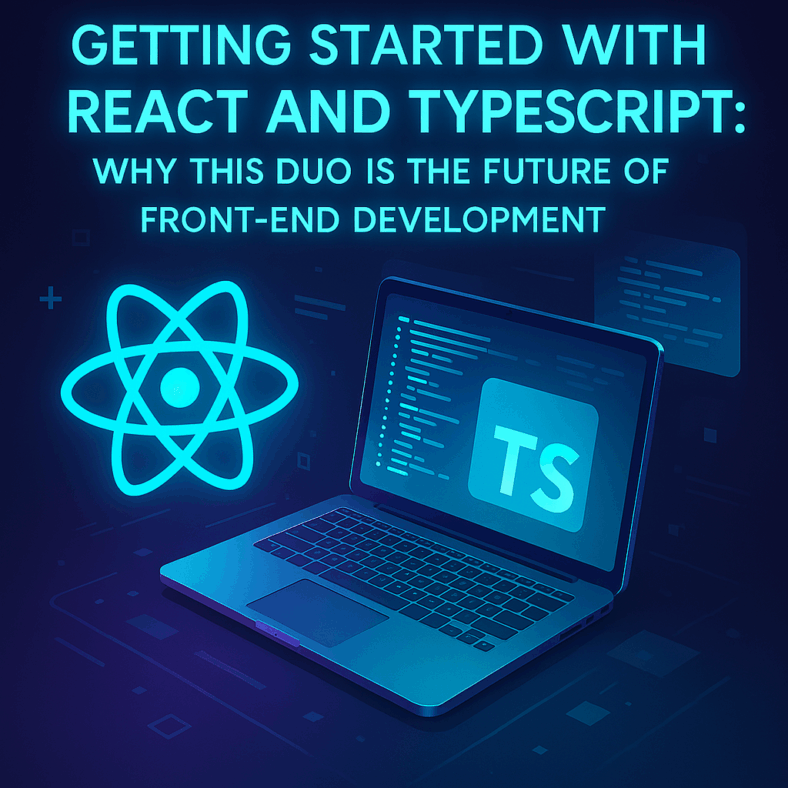In the fast-paced world of web development, building scalable, maintainable, and error-free applications is a top priority. That’s where React and TypeScript come into play.
React is a powerful JavaScript library developed by Facebook for building user interfaces. It allows developers to create dynamic and reusable UI components with ease, making it one of the most popular front-end tools today.
TypeScript, on the other hand, is a statically typed superset of JavaScript developed by Microsoft. It adds type definitions to JavaScript code, enabling developers to catch errors during development rather than at runtime.
When used together, React and TypeScript offer a robust development experience. TypeScript enhances React applications with improved tooling, better readability, and safer code — making the development process smoother and more reliable.
This article will walk you through the key reasons why combining React with TypeScript is a game-changer. We’ll explore their individual strengths, how they complement each other, and the practical benefits of using them side-by-side in modern web projects.
Context: The Rise of React and TypeScript
React was first released in 2013 and quickly revolutionized the way developers build front-end applications. Its component-based architecture, virtual DOM, and declarative programming model made it easier to build interactive UIs at scale.
Meanwhile, JavaScript, despite being powerful, is dynamically typed. This means that type-related bugs often go unnoticed until runtime. Enter TypeScript, introduced in 2012, offering developers a way to write cleaner and more predictable code by enforcing type safety.
Static typing—one of TypeScript’s core features—ensures that variables, function arguments, and return values follow strict type definitions. This prevents many common bugs and helps teams maintain large codebases more effectively.
The combination of React’s flexibility and TypeScript’s safety results in more stable applications and a smoother development workflow. Together, they address two major concerns: UI complexity and code reliability.
Why Use React with TypeScript? The Key Benefits
1. Early Error Detection and Code Safety
TypeScript catches errors during the development process, helping you identify mistakes before your code even runs. This means fewer bugs, faster debugging, and more reliable applications.
2. Enhanced IDE Support
Tools like Visual Studio Code shine when TypeScript is involved. With TypeScript, you get intelligent autocomplete, better navigation, and safer refactoring — all of which boost developer productivity.
3. Cleaner and More Maintainable Code
By defining types for props, state, and functions, your React components become easier to understand and maintain. This leads to more readable code and fewer surprises when working with unfamiliar codebases.
4. Improved Team Collaboration
TypeScript makes your code self-documenting. Team members can understand what a component expects and returns just by looking at the type annotations. This reduces miscommunication and increases development speed, especially in larger teams.
Claro! Aqui está a continuação do artigo, cobrindo os tópicos de 6 a 11 do seu checklist:
6. Core Concepts: Typing React Components
When working with React and TypeScript, one of the first things you’ll encounter is how to define types for props and state.
Defining Props with Interfaces
The most common approach is to create an interface that describes the shape of your props.
interface GreetingProps {
name: string;
}
const Greeting: React.FC<GreetingProps> = ({ name }) => {
return <h1>Hello, {name}!</h1>;
};
In this example, GreetingProps ensures that the name prop must be a string.
Typing Component State
You can type state variables directly when using useState.
const [count, setCount] = useState<number>(0);
This ensures that count will always be a number, and any attempt to set it to another type will result in a compile-time error.
Common TypeScript Types in React
React.FC<Props>– A generic type for functional components.React.ChangeEvent<HTMLInputElement>– Used for typing form events.React.MouseEvent<HTMLButtonElement>– Used for button click events.React.ReactNode– Represents anything that can be rendered (text, elements, fragments, etc).
7. Practical Examples
Component with Typed Props
interface ButtonProps {
label: string;
onClick: () => void;
}
const CustomButton: React.FC<ButtonProps> = ({ label, onClick }) => {
return <button onClick={onClick}>{label}</button>;
};
Using Hooks with TypeScript
const Counter: React.FC = () => {
const [count, setCount] = useState<number>(0);
useEffect(() => {
console.log(`Count updated: ${count}`);
}, [count]);
return (
<div>
<p>{count}</p>
<button onClick={() => setCount(count + 1)}>Increment</button>
</div>
);
};
Typing Events
const handleInputChange = (event: React.ChangeEvent<HTMLInputElement>) => {
console.log(event.target.value);
};
8. Challenges and Tips
Common Pitfalls
- Overusing
any: Avoid falling back toanyas it defeats the purpose of using TypeScript. - Incorrectly typed events: Always use the appropriate event type (e.g.,
ChangeEvent,MouseEvent).
Dealing with Untyped Libraries
If a third-party library doesn’t provide TypeScript support, try installing its type definitions:
npm install --save-dev @types/library-name
If none are available, use type assertions or create your own minimal declarations.
Best Practices
- Always type props and state.
- Prefer specific types over
any. - Keep interfaces small and focused.
- Use enums and union types to limit valid values.
9. Tools and Resources
Recommended Tools
- VSCode – Excellent TypeScript support and React snippets.
- ESLint – Enforces code quality and helps avoid bugs.
- Prettier – Ensures consistent formatting.
Official Documentation
Suggested Courses
- TypeScript with React (freeCodeCamp, Codecademy, Udemy)
- Microsoft Learn: TypeScript for Beginners
Conclusion
React and TypeScript are a perfect match for building scalable, safe, and maintainable front-end applications. While React offers the flexibility to build powerful UIs, TypeScript brings structure and safety to your codebase.
By learning how to type props, state, events, and hooks, you’ll be able to write code that is not only more robust but also easier to understand and debug.
Whether you’re working solo or in a team, using React with TypeScript is an investment in quality, maintainability, and long-term productivity.
If you found this guide helpful, consider following for more development articles, or check out our other posts on modern web development.
📚 Ready to dive deeper? Explore these resources:




